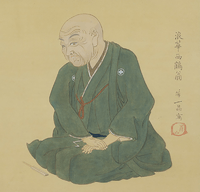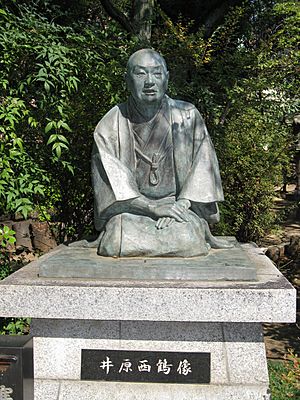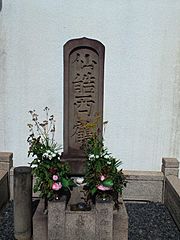Ihara Saikaku facts for kids
Quick facts for kids
Ihara Saikaku
井原 西鶴 |
|
|---|---|

Portrait of Ihara Saikaku
|
|
| Born | 1642 Osaka, Japan |
| Died | 1693 Osaka |
| Occupation | Writer |
| Genre | Poetry, Fiction |
| Literary movement | Ukiyo-zōshi |
Ihara Saikaku (井原 西鶴, 1642 – September 9, 1693) was a Japanese poet and creator of the "floating world" genre of Japanese prose (ukiyo-zōshi).
Born as Hirayama Tōgo (平山藤五), the son of a wealthy merchant in Osaka, he first studied haikai poetry under Matsunaga Teitoku and later studied under Nishiyama Sōin of the Danrin school of poetry, which emphasized comic linked verse. Scholars have described numerous extraordinary feats of solo haikai composition at one sitting; most famously, over the course of a single day and night in 1677, Saikaku is reported to have composed at least 16,000 haikai stanzas, with some sources placing the number at over 23,500 stanzas.
Later in life he began writing accounts of the financial and amorous affairs of the merchant class and the demimonde.
Biography

Ihara Saikaku was born in 1642 into a well-off merchant family in Osaka. From the age of fifteen he composed haikai no renga (linked verse). In 1662 at the age of twenty he became a haikai master. Under the pen name Ihara Kakuei, he began to establish himself as a popular haikai poet. By 1670 he had developed his own distinctive style, using colloquial language to depict contemporary chōnin life. During this time he owned and ran a medium-sized business in Osaka.
In 1673 he changed his pen name to Saikaku. However, the death of his dearly beloved wife in 1675 had an extremely profound impact on him. A few days after her death, in an act of grief and true love, Saikaku started to compose a thousand-verse haikai poem over twelve hours. When this work was published it was called Haikai Single Day Thousand Verse (Haikai Dokugin Ichinichi). It was the first time that Saikaku had attempted to compose such a lengthy piece of literature. The overall experience and success that Saikaku received from composing such a mammoth exercise has been credited with sparking the writer's interest in writing novels.
Shortly after his wife's death, the grief-stricken Saikaku decided to become a lay monk and began to travel all across Japan, thus leaving behind his three children (one of whom was blind) to be cared for by his extended family and his business by his employees. He started his travels after the death of his blind daughter.
In 1677 Saikaku returned to Osaka and had learned of the success his thousand-verse haikai poem had received. From then on he pursued a career as a professional writer. Initially Saikaku continued to produce haikai poetry, but by 1682 he had published The Life of an Amorous Man, the first of his many works of prose fiction.
As Saikaku's popularity and readership began to increase and expand across Japan, so did the amount of literature he published. When he died in 1693, at the age of fifty-one, Saikaku was one of the most popular writers of the entire Tokugawa period. At the time his work was never considered "high" literature because it had been aimed towards and popularised by the chōnin. Nevertheless, Saikaku's work is now celebrated for its significance in the development of Japanese fiction.
Works
Townspeople (町人 chōnin) stories
- Twenty Cases of Unfilial Children (本朝二十不孝, Honchō Nijū Fukō, 1686)
- The Eternal Storehouse of Japan (日本永代蔵, Nippon Eitaigura, 1688)
- Reckonings that Carry Men Through the World or This Scheming World (世間胸算用, Seken Munesan'yō, 1692)
Warrior stories
- Transmission of the Martial Arts (武道伝来記, Budō Denraiki, 1687)
- Tales of Samurai Honor (武家義理物語, Buke Giri Monogatari, 1688)
See also
 In Spanish: Ihara Saikaku para niños
In Spanish: Ihara Saikaku para niños


